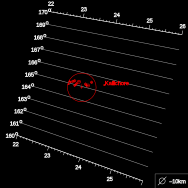Carme group

The Carme group is a group of retrograde irregular satellites of Jupiter that follow similar orbits to Carme and are thought to have a common origin.
Their semi-major axes (distances from Jupiter) range between 22.7 and 23.6 Gm, their orbital inclinations between 164.4° and 164.9°, and their orbital eccentricities between 0.25 and 0.28 (with one exception).
The Carme group members are:[1][2]

| Name | Diameter (km)[3] |
Period (days)[4][a] |
Notes |
|---|---|---|---|
| Carme | 46 | –734.19 | largest member and group prototype |
| Taygete | 5 | –732.45 | |
| Chaldene | 4 | –723.71 | |
| Kalyke | 5 | –742.02 | substantially redder than the others |
| Erinome | 3 | –728.48 | |
| Isonoe | 4 | –726.27 | |
| Aitne | 3 | –730.10 | |
| Kale | 2 | –729.64 | |
| Pasithee | 2 | –719.47 | |
| Arche | 3 | –731.88 | |
| Kallichore | 2 | –728.26 | |
| Eukelade | 4 | –730.30 | |
| Herse | 2 | –734.52 | |
| S/2010 J 1 | 2 | –736.51 | |
| Eirene | 4 | –729.84 | |
| S/2003 J 19 | 2 | –734.78 | |
| S/2017 J 2 | 2 | –724.71 | |
| S/2017 J 5 | 2 | –737.28 | |
| S/2017 J 8 | 1 | –719.76 | |
| S/2011 J 1 | 2 | –733.21 | |
| S/2003 J 9 | 1 | –736.86 | |
| S/2003 J 10 | 2 | –755.43 | |
| S/2003 J 24 | 2 | –721.60 | |
| S/2016 J 3 | 2 | –713.64 | |
| S/2018 J 3 | 1 | –747.02 | |
| S/2021 J 4 | 1 | –728.28 | |
| S/2021 J 5 | 2 | –747.74 | |
| S/2021 J 6 | 1 | –720.97 | |
| S/2022 J 1 | 2 | –738.33 | |
| S/2022 J 2 | 1 | –781.56 |
The International Astronomical Union (IAU) reserves names ending in -e for all retrograde moons.
Origin
[edit]The very low dispersion of the mean orbital elements[b] among the core members (the group is separated by less than 900,000 km in semi major axis and only 0.5° in inclination) suggests that the Carme group may once have been a single body that was broken apart by an impact. The dispersion can be explained by a very small velocity impulse (5 < δV < 50 m/s).[5] The parent body was probably about the size of Carme, 46 km in diameter; 99% of the group's mass is still located in Carme.[6]
Further support to the single body origin comes from the known colours: all the satellites appear light red,[c] with colour indices B-V= 0.76 and V-R= 0.47[7] and infrared spectra, similar to D-type asteroids.[8] These data are consistent with a progenitor from the Hilda family or a Jupiter trojan.
Notes
[edit]- ^ Negative period is indicative of retrograde motion.
- ^ Osculating orbital parameters of irregular satellites of Jupiter change widely in short intervals due to heavy perturbation by the Sun. For example, changes of as much as 1 Gm in semi-major axis in 2 years, 0.5 in eccentricity in 12 years, and as much as 5° in 24 years have been reported. Mean orbital elements are the averages calculated by the numerical integration of current elements over a long period of time, used to determine the dynamical families.
- ^ With the exception of Kalyke, which is substantially redder.
References
[edit]- ^ Scott S. Sheppard, David C. Jewitt, Carolyn Porco Jupiter's outer satellites and Trojans, In: Jupiter. The planet, satellites and magnetosphere. Edited by Fran Bagenal, Timothy E. Dowling, William B. McKinnon. Cambridge planetary science, Vol. 1, Cambridge, UK: Cambridge University Press, ISBN 0-521-81808-7, 2004, p. 263 – 280 Full text(pdf). Archived June 14, 2007, at the Wayback Machine
- ^ David Nesvorný, Cristian Beaugé, and Luke Dones. Collisional Origin of Families of Irregular Satellites, The Astronomical Journal, 127 (2004), pp. 1768–1783 Full text.
- ^ "Moons of Jupiter". Carnegie Science. Minor Planet Center. 27 August 2019.
- ^ "Planetary Satellite Mean Elements". Jet Propulsion Laboratory. California Institute of Technology. 25 January 2024.
- ^ David Nesvorný, Jose L. A. Alvarellos, Luke Dones, and Harold F. Levison. Orbital and Collisional Evolution of the Irregular Satellites, The Astronomical Journal,126 (2003), pages 398–429. (pdf) Archived 15 April 2020 at the Wayback Machine
- ^ Sheppard, Scott S.; Jewitt, David C. (5 May 2003). "An abundant population of small irregular satellites around Jupiter". Nature. 423 (6937): 261–263. Bibcode:2003Natur.423..261S. doi:10.1038/nature01584. PMID 12748634. S2CID 4424447.
- ^ Grav, Tommy; Holman, Matthew J.; Gladman, Brett; Aksnes, Kaare (2 January 2003). "Photometric Survey of the Irregular Satellites". Icarus. 166: 33–45. Retrieved 2 January 2024 – via ArXiv.
- ^ Grav, Tommy; Holman, Matthew J. (22 December 2003). "Near-Infrared Photometry of Irregular Satellites of Jupiter and Saturn". The Astrophysical Journal. 605: L141–L144. Retrieved 2 January 2024 – via ArXiv.


